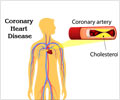Heart attack could be predicted more effectively if cardiac hybrid imaging is used rather than invasive coronary angiography alone when evaluating patients with coronary artery disease.
Highlights:
- Cardiac hybrid imaging is an excellent long-term predictor of heart attack in patients being checked for coronary artery disease
- Hybrid imaging uses a combination of computed tomography (CT) and nuclear stress testing that detects narrowing of the coronary artery and inadequate perfusion (ischemia) or blood flow to the heart simultaneously
- Fusion imaging can help determine whether coronary revascularization is needed or not.
However, ICA does not give any information on perfusion which is important to predict a heart attack risk accurately. Perfusion is the flow of blood into the heart muscle and inadequate perfusion, also known as ischemia, is a potential danger to the patient.
To measure the degree of stenosis (morphological information) as well as myocardial perfusion (functional information) in a single setting, a technique used nowadays is cardiac hybrid imaging.
Cardiac hybrid imaging consists of a combination (or 'fusion') of computed tomography coronary angiography (CCTA) and myocardial perfusion imaging (MPI) techniques (single photon emission computed tomography, SPECT, or positron emission tomography, PET) to diagnose CAD.
"In lesions with less than 50 percent narrowing, one in five lesions still produce an ischemia," said study co-author Philipp A. Kaufmann, M.D., professor and chair of nuclear medicine, and director of cardiac imaging at University Hospital Zurich in Switzerland.
Study Design and Results
So far, the cardiac hybrid imaging approach has shown promise in studies that focus only on short-term observations; the current research is the first one to find information on long-term outcomes.The data sets of SPECT and CCTA imaging were fused, and the images were assigned to one of the following three categories: matched findings, unmatched findings, and normal findings. Normal findings were normal CCTA findings or any luminal narrowing less than 50 percent and no defect at SPECT.
- Patients with stenosis of 50 percent or more along with visible ischemia in the area of the heart which was supplied blood by the blocked vessel (matched findings), had more than five times the risk of adverse events than those with normal findings.
- Patients with stenosis of 50 percent or more along with visible ischemia that was not in the area of the heart fed by the blocked artery (unmatched findings), had three times the risk of adverse cardiac events.
- During this follow-up period, there were 160 major adverse cardiac events, including 45 deaths in the final study population that comprised of 375 patients.
- The rates of the major adverse cardiac events were 21.8 percent for matched findings and 9.0 percent for unmatched, both groups considerably higher than the 2.4 percent rate for normal findings.
The study supports the use of CCTA for initial, non-invasive evaluation of patients with known or suspected stable coronary artery disease. If the results appear normal, no additional imaging would be necessary. But, if a lesion is evident, then clinicians could employ a nuclear scan to check the presence of ischemia and take advantage of both modalities by fusing the results together to make a hybrid image.
"The strategy of direct referral to invasive coronary angiography without non-invasive imaging is obsolete," Dr. Kaufmann said. "Even after documenting coronary artery disease with coronary CT angiography, we need further non-invasive evaluation before deciding upon revascularization versus medication."
The researchers have plans of running a clinical trial to show that hybrid imaging can have a positive impact on patient outcomes. They are also planning to combine the CCTA/SPECT hybrid with information on coronary artery shear stress (something they call "triple hybrid" imaging), which could help identify lesions that as of now do not have an impact on ischemia but will in the future.
References:
- Aju P. Pazhenkottil, Dominik C. Benz, Christoph Gräni, Michael A. Madsen, Fran Mikulicic, Elia von Felten, Tobias A. Fuchs, Beatrice Hirt Moch, Julia Stehli, Thomas F. Lüscher, Oliver Gaemperli, Ronny R. Buechel, Philipp A. Kaufmann. Hybrid SPECT Perfusion Imaging and Coronary CT Angiography: Long-Term Prognostic Value for Cardiovascular Outcomes. Radiology, 2018
- Gaemperli O, Bengel FM, Kaufmann PA. Cardiac hybrid imaging. Eur Heart J. 2011 Sep
Source-Medindia
















